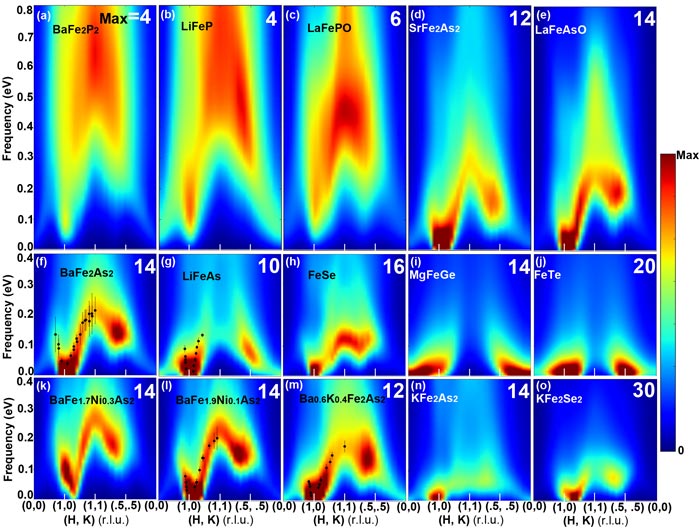Iron-Based Superconductor Simulations Spin Out New Possibilities on Titan

The 15 boxes in this image show the simulated intensity of spin excitations in 15 iron-based materials, including iron compounds that are high-temperature superconductors (images d–h). The x axis shows the momentum of the spin excitation in selected locations of 3D space, and the y axis shows the energy measured in electron volts (eV). The color code indicates the intensity of spin excitations with a given energy and momentum, which is compared with available experimental results (shown in black bars in images f, g, l, and m). The locations with the greatest number of spin excitations are shown in red with decreasing frequency shown from orange to blue. By visualizing the spin dynamics of multiple iron-based materials—information that can be time-consuming and expensive to collect experimentally—researchers can better predict which materials are likely to be superconducting.
Researchers studying iron-based superconductors are combining novel electronic structure algorithms with the high-performance computing power of the Department of Energy’s Titan supercomputer at Oak Ridge National Laboratory to predict spin dynamics, or the ways electrons orient and correlate their spins in a material. Because researchers have suggested that spin dynamics create the conditions needed for superconductivity, this approach could expedite the search for new or modified materials that conduct electricity with little or no resistance at higher temperatures, unlike current commercial superconductors, which must be expensively cooled to exhibit superconducting properties.
In a Nature Physics paper published in October, Zhiping Yin, Kristjan Haule, and Gabriel Kotliar of Rutgers University compute the dynamic spin structure factors—or the measure of how the spins of electrons align relative to each other at a given distance at different times—of 15 iron-based materials, including several high-temperature superconductors, in unprecedented detail.
“Our computational results are in good agreement with experimental results for experiments that have been performed, and we have several predictions for compounds that have not yet been measured,” Kotliar said. “Once we validate the theory that our computational models are based on with experiments, then we can investigate materials computationally that are not being studied experimentally.”
Computation offers a way for researchers to better understand spin dynamics and other material properties under many conditions, such as temperature change, rather than the singular condition present during a given experiment. Computation also allows researchers to simulate many of these materials at once, and the number of potential materials to explore rapidly increases as scientists introduce modifications to improve performance.
With the computational power at hand on the 27-petaflop Titan system managed by the Oak Ridge Leadership Computing Facility, the team was able to compare and contrast spin dynamics for all 15 materials simulated to identify tell-tale superconducting properties.
“By comparing simulations and experiments, we learned about which type of spin fluctuations actually promote superconductivity and which ones do not,” Kotliar said.
In their model, the team used a technique called Dynamical Mean Field Theory to reduce the vast number of interactions involving electrons in a unit cell (the most detailed slice of material simulated) and averaged these interactions in a mean field environment across the rest of the solid. The team used the Monte Carlo method to statistically select the best solutions for these techniques, achieving a new level of predictive accuracy for spin dynamics in these kinds of materials.
“We find these complex problems, as in superconductors, where you have to solve many degrees of freedom or a large number of variables, require supercomputing rather than computing on smaller clusters,” Haule said. “Our algorithms are designed to work very efficiently on Titan’s massively parallel architecture.”
Using 20 million processor-hours on Titan, the team also discovered through simulation a new superconducting state, or electron pairing, found in the lithium-iron-arsenic compound, LiFeAs, that is consistent with experimental results.
In the future, they plan to simulate spin dynamics in other classes of superconductors and in non-superconducting materials that are exceptionally difficult to study experimentally, such as radioactive materials.
“Using computation as a substitute for experiment is an important step forward for designing new materials,” Kotliar said. “The next time someone comes to us with potential materials for an application and asks, ‘Should I work on this?’ we hope to simulate that material through computation to select the most promising ones.”
The work was supported by the National Science Foundation and made use of the Oak Ridge Leadership Computing Facility, a DOE Office of Science User Facility at ORNL.
UT-Battelle manages ORNL for the Department of Energy's Office of Science. The Office of Science is the single largest supporter of basic research in the physical sciences in the United States, and is working to address some of the most pressing challenges of our time.
For more information, please visit http://science.energy.gov/
Katie Elyce Jones
Media Contact
All latest news from the category: Materials Sciences
Materials management deals with the research, development, manufacturing and processing of raw and industrial materials. Key aspects here are biological and medical issues, which play an increasingly important role in this field.
innovations-report offers in-depth articles related to the development and application of materials and the structure and properties of new materials.
Newest articles

First-of-its-kind study uses remote sensing to monitor plastic debris in rivers and lakes
Remote sensing creates a cost-effective solution to monitoring plastic pollution. A first-of-its-kind study from researchers at the University of Minnesota Twin Cities shows how remote sensing can help monitor and…

Laser-based artificial neuron mimics nerve cell functions at lightning speed
With a processing speed a billion times faster than nature, chip-based laser neuron could help advance AI tasks such as pattern recognition and sequence prediction. Researchers have developed a laser-based…

Optimising the processing of plastic waste
Just one look in the yellow bin reveals a colourful jumble of different types of plastic. However, the purer and more uniform plastic waste is, the easier it is to…



